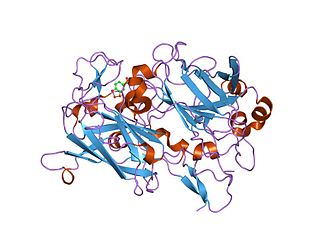Catechol dioxygenases are metalloprotein enzymes that carry out the oxidative cleavage of catechols. This class of enzymes incorporate dioxygen into the substrate. Catechol dioxygenases belong to the class of oxidoreductases and have several different substrate specificities, including catechol 1,2-dioxygenase, catechol 2,3-dioxygenase, and protocatechuate 3,4-dioxygenase. The active site of catechol dioxygenases most frequently contains iron, but manganese-containing forms are also known.

Catechol 1,2- dioxygenase is an enzyme that catalyzes the oxidative ring cleavage of catechol to form cis,cis-muconic acid:
In enzymology, a 2-chlorobenzoate 1,2-dioxygenase (EC 1.14.12.13) is an enzyme that catalyzes the chemical reaction
In enzymology, a 2-hydroxyquinoline 5,6-dioxygenase (EC 1.14.12.16) is an enzyme that catalyzes the chemical reaction
In enzymology, a 4-chlorophenylacetate 3,4-dioxygenase (EC 1.14.12.9) is an enzyme that catalyzes the chemical reaction
In enzymology, an anthranilate 1,2-dioxygenase (deaminating, decarboxylating) (EC 1.14.12.1) is an enzyme that catalyzes the chemical reaction
In enzymology, an anthranilate 3-monooxygenase (deaminating) (EC 1.14.13.35) is an enzyme that catalyzes the chemical reaction

In enzymology, a benzene 1,2-dioxygenase is an enzyme that catalyzes the chemical reaction
In enzymology, a biphenyl 2,3-dioxygenase (EC 1.14.12.18) is an enzyme that catalyzes the chemical reaction
In enzymology, a melilotate 3-monooxygenase (EC 1.14.13.4) is an enzyme that catalyzes the chemical reaction
In enzymology, a toluene dioxygenase (EC 1.14.12.11) is an enzyme that catalyzes the chemical reaction
In enzymology, a 3,4-dihydroxy-9,10-secoandrosta-1,3,5(10)-triene-9,17-dione 4,5-dioxygenase (EC 1.13.11.25) is an enzyme that catalyzes the chemical reaction
In enzymology, a 3,4-dihydroxyphenylacetate 2,3-dioxygenase (EC 1.13.11.15) is an enzyme that catalyzes the chemical reaction
In enzymology, a 3-carboxyethylcatechol 2,3-dioxygenase (EC 1.13.11.16) is an enzyme that catalyzes the chemical reaction
In enzymology, a 3-hydroxy-2-methylquinolin-4-one 2,4-dioxygenase (EC 1.13.11.48) is an enzyme that catalyzes the chemical reaction
In enzymology, a 3-hydroxy-4-oxoquinoline 2,4-dioxygenase (EC 1.13.11.47) is an enzyme that catalyzes the chemical reaction
In enzymology, a cysteamine dioxygenase (EC 1.13.11.19) is an enzyme that catalyzes the chemical reaction
In enzymology, an indole 2,3-dioxygenase (EC 1.13.11.17) is an enzyme that catalyzes the chemical reaction

In enzymology, a quercetin 2,3-dioxygenase (EC 1.13.11.24) is an enzyme that catalyzes the chemical reaction

Dioxygenases are oxidoreductase enzymes. Aerobic life, from simple single-celled bacteria species to complex eukaryotic organisms, has evolved to depend on the oxidizing power of dioxygen in various metabolic pathways. From energetic adenosine triphosphate (ATP) generation to xenobiotic degradation, the use of dioxygen as a biological oxidant is widespread and varied in the exact mechanism of its use. Enzymes employ many different schemes to use dioxygen, and this largely depends on the substrate and reaction at hand.





